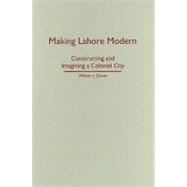
| Acknowledgments | p. vii |
| Introduction | p. xi |
| An Urban Palimpsest: The Precolonial Development of Lahore | p. 1 |
| A Colonial Spatial Imagination: British Knowledge of the City and Its Environs | p. 27 |
| Collaborations: Building an Elite Landscape in Lahore's Civil Station | p. 59 |
| Changing Houses: Rethinking and Rebuilding Townhouses and Neighborhoods | p. 99 |
| Anxieties at Home: The Disquieting British Bungalow | p. 159 |
| Thinking with the City: Urban Writing in Colonial Lahore | p. 185 |
| Notes | p. 203 |
| Bibliography | p. 233 |
| Index | p. 255 |
| Table of Contents provided by Ingram. All Rights Reserved. |
The New copy of this book will include any supplemental materials advertised. Please check the title of the book to determine if it should include any access cards, study guides, lab manuals, CDs, etc.
The Used, Rental and eBook copies of this book are not guaranteed to include any supplemental materials. Typically, only the book itself is included. This is true even if the title states it includes any access cards, study guides, lab manuals, CDs, etc.